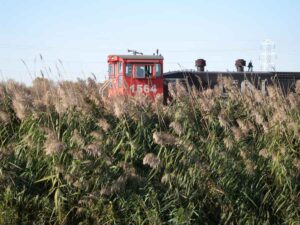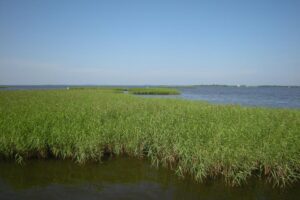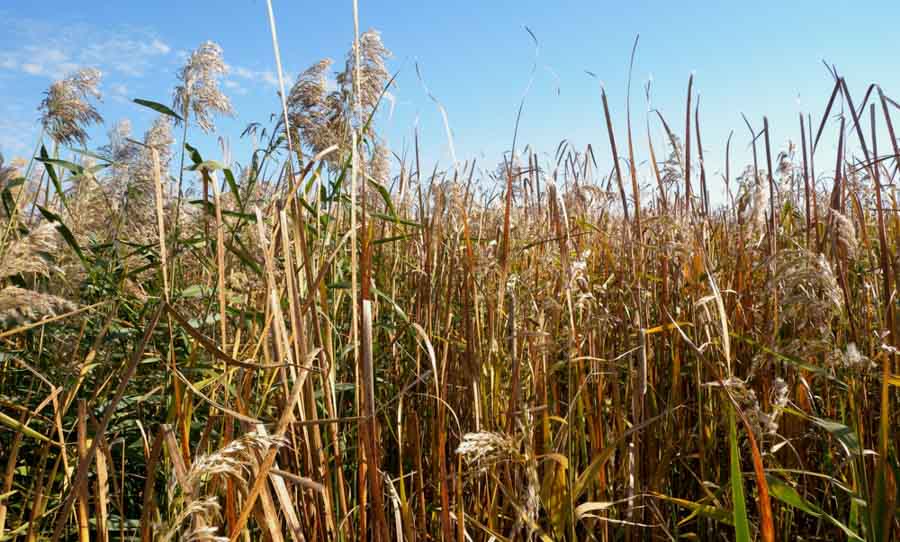Common Reed (Phragmites australis)
Other names: Cane, Reed, Giant Reed, Phragmites

Subspecies
North American (native to the U.S.) Phragmites australis subsp. americanus
European (invasive in U.S.) Phragmites australis subsp. australis
Plant Family: Grass, Poaceae
Synonym: Phragmites communis
Phragmites or Common Reed is an amazing plant in the natural world and has been utilized by humans for thousands of years. Phragmites is found on every continent except Antarctica, in a variety of aquatic and wetland habitats. The species can be divided into several varieties or subspecies, depending on the authority. The European variety is now classified as a subspecies by many is highly invasive in North American wetlands. It will even out-compete and replace invasive cattails and its North American phragmites sibling. It is most often found in wetlands but can also make its way to less dry uplands.
All varieties are very tall grasses and often much taller than other plant community members other than trees and small shrubs.

North American Phragmites
Like most wetland grasses and sedges, phragmites’ native strain is often found in thick stands that from a distance look like they lack other species. However, often there is a variety of other much shorter wetland plants growing under the tall Phragmites. This is because although the plants are tall, they grow less densely than the invasive variety, but I have seen them growing very densely in a few locations.
Invasive European Phragmites
Invasive Phragmites takes over native wetlands in much the same way as invasive cattails do. The plants grow close together and often are two to three times taller than most native vegetation. They compete for nutrients and water, but it is light that they rob native plants most of.
The second major problem is that invasive Phragmites growth produces large amounts of dead leaves and stems that act as a mulch, smothering native plants, much like a gardener uses mulch to prevent the growth of weeds. Phragmites grows fast, and large nutrient reserves in its roots and the relatively robust shoot can push its way up through the tangle of leaf and stem litter in spring. More fragile sedge leaves have a much harder time coping with this situation.
Third, there is evidence Phragmites uses allelopathy to reduce the growth of competitors. Allelopathy is the production of chemicals by a plant or other organisms that affect the growth of or kills nearby competing organisms. This can be a chemical produced directly by the plant or a byproduct of its decomposition. Non-native Phragmites secretes gallic acid, which poisons and kills the roots of other plants. When tested, Native Phragmites had less of an effect on other species than the Non-native Phragmites (Rudrappa et al. 2007).

Identification of Phragmites Subspecies
Non-native Phragmites is a much more robust plant than the native. It is taller, has larger seed heads and leaves. See photo and caption below.

Human Use of Phragmites
Phragmites are still widely used as a building material, although modern materials have mostly taken their place in the developed world. However, in many European countries, the grass is commercially by hand, but more often by machines specifically designed for the task. The main use of the Phragmites today is for thatching roofs. A well-thatched roof made from phragmites will keep the rain out for decades and is said to outlast asphalt shingles. A thatched roof’s advantage over an asphalt one is that it is a renewable resource and is biodegradable. In the past, Phragmites were used for arrow shafts, torches, baskets floor, and sleeping mats, and many other things.
Resources and references:
Rudrappa T, Bonsall J, Gallagher JL, Seliskar DM, Bais HP. 2007 Root-secreted allelochemical in the noxious weed Phragmites australis deploys a reactive oxygen species response and microtubule assembly disruption to execute rhizotoxicity. Journal of Chemical Ecology. 33:10 1898-918
